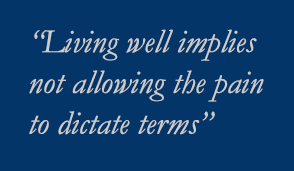Enervating, irksome, debilitating, back pain––particularly severe back pain––can significantly affect the quality of one’s hours and days. The trick is to live well notwithstanding its presence. This requires both patience and impatience: patience, to allow the body time to heal; impatience, to alleviate at once its most acute symptoms. Living well implies not allowing the pain to dictate terms. You still remain active and busy, but within limits. You plan and make adjustments so that your day is as close to normal as you can possibly make it. There are other methods as well:
Apply Heat Regularly. There’s medical literature which establishes the efficacy of regularly-applied heat. “In this regard, a study by Khadilkar et al., on treatment of chronic low back pain indicated that keeping the pain site warm (wrapped up by a blanket) for a long term in the patients with chronic low back pain reduced the pain efficiently. In the present study, thermotherapy [use of a hot water bottle] minimized acute low back pain in short term. This inconsistency may be due to different instruments (blanket versus hot water bottle) for keeping the pain site warm. Thermotherapy also decreased the intensity of pain in the first and second trimesters of pregnancy in various measures. Continuous application of thermotherapy in a low level was effective on treating acute low back pain and nonspecific low back pain, confirming our findings. The results of a study on low back pain in adults showed that thermotherapy after five days reduced pain significantly compared to oral placebo. In that study, acute low back pain was relieved immediately after thermotherapy, confirming the efficacy of thermotherapy (blanket wrapped up for two weeks) on pain relief and inabilities associated with low back pain of shorter than three months.”[1]
Exercise. Many believe that some forms of back pain result from deconditioned lumbar trunk muscles. The thought is that exercise can strengthen these, leading over time to reduced pain. “This study indicates that exercise programs increase muscular endurance in a sample of commercial helicopter pilots with flying related transient LBP [low back pain]. Both program A and B increased lumbar trunk muscular endurance and LMM [lumbar multifidus muscle] contractility. Program B improved pain, function and health-related quality of life after training. Our findings indicate that helicopter pilots with transient LBP obtain marked improvement in function of the lumbar trunk muscles with training and that this is followed by less lumbar complaints related to flying. The origins of LBP are heterogeneous and also controversial and most probably different mechanisms are involved in LBP in different individuals. The importance of deconditioned lumbar trunk muscles has received increased attention in research and strategies for management of LBP. Measurements of muscular endurance in the lumbar region and especially the ability to contract the LMM seem to be a valid measure of the function of the lumbar trunk muscles.”[2]
Listen to Music. Listening to the right kind of music (“well-loved music”) has been shown to have analgesic properties as well. “Additionally, the preferred personal music could have yielded maximal experimentally detectable endogenous analgesia in a ceiling effect. We believe that the strength of the analgesic effects were likely due to the latent conditioned relationships subjects had with their songs, leading to a more complex view of music as an analgesic agent. We suggest it can be viewed in the same framework that placebo responses are increasingly being seen in – that of a rich, nuanced set of contextual personal factors. An individual’s song becomes connected over time to people, places, and circumstances such that there is a robust latent effect from the history and time spent with the music. Indeed, additional analyses of systematically gathered, qualitative participant experiences revealed themes consistent with those seen in the nascent field of neurobehavioral music research…”[3]
Emerging Treatments. One emerging treatment, not widely recognized, involves injecting sterile water. “This finding indicated that, on average, ISWI [intracutaneous sterile water injection] induced a greater reduction in pain than did intracutaneous injections of isotonic saline. This difference was also observed at 45 min, 90 min, and 1 day post-treatment… This study shows the safety and efficacy of ISWI versus placebo (isotonic saline) in patients with aLBP [acute low back pain]. ISWI provided a higher degree of pain relief and functional improvement than did placebo injections. These results suggest that ISWI has superior effects on reduction of pain and improvement in functional status, as shown by the VAS [visual analogue scale] scores of aLBP and PSFS [Patient-Specific Functional Scale] scores, compared with isotonic saline injection.”[4]
Back pain will be with us until a genuine breakthrough occurs in the science of pain. Until more is known about how the brain perceives and processes pain, symptomatic treatment will continue to remain the standard approach. When that moment finally arrives when back pain is vanquished, large numbers will exhale a collective sigh of relief. In the meantime, chronic back pain need not prevent one from living well. It requires planning and thought, and the presence of mind not to generalize its effects. After all, merely because things are not perfect, they still can be so close to perfection that you cannot tell the difference.
[1] Morteza Dehghan, Farinaz Farahbod, The Efficacy of Thermotherapy and Cryotherapy on Pain Relief in Patients with Acute Low Back Pain, a Clinical Trial Study, J Clin Diagn Res. 2014 Sep; 8(9): LC01–LC04.
[2] Knut Andersen, Roald Baardsen, Ingvild Dalen, Jan Petter Larsen, Impact of exercise programs among helicopter pilots with transient LBP, BMC Musculoskelet Disord. 2017; 18: 269
3] Christine Hsieh, Jian Kong, Irving Kirsch, Robert R. Edwards, Karin B. Jensen, Ted J. Kaptchuk, Randy L. Gollub, Well-Loved Music Robustly Relieves Pain: A Randomized, Controlled Trial, PLoS One. 2014; 9(9): e107390.
[4] J.Z. Cui, Z.S. Geng, Y.H. Zhang, J.Y. Feng, P. Zhu, X.B. Zhang, Effects of intracutaneous injections of sterile water in patients with acute low back pain: a randomized, controlled, clinical trial, Braz J Med Biol Res. 2016; 49(3): e5092.




